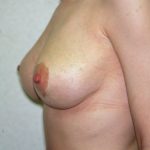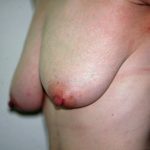The female breast is not a stable anatomic structure. Given the forces of gravity, aging, and pregnancies, breasts that become saggy aren’t a matter of if it will happen but when and how much for almost all women. If a woman has large natural breasts to start, sagginess or ptosis may occur sooner or to a greater degree than a smaller breast.
Whether it is a breast lift or reduction, these plastic surgery operations are designed to lift and tighten the saggy breast. While these procedures are very effective in the short-term, some relaxation or small amount of sagging will eventually return. The elevated nipple position does not drop, but the lower pole of the breast will bottom out to some degree. This is why these operations are ‘overcorrected’, the breast is made too high, to account for this inevitable postoperative change.
The main reason that some bottoming out of the breast occurs is that the support for the reshaped breast is that of skin only. This skin is usually very thin and is very prone to stretching out with immediate swelling from the surgery and the eventual weight of the breast tissue that it envelopes. Many efforts have been made as to how to improve internal breast support, from operative design alterations to synthetic mesh implants, but none has proved to be consistently successful or well accepted by most plastic surgeons.

The laser is used to preserve the more of the skin’s thickness that overlies the pedicle of breast tissue that supports the nipple. Rather than discarding this valuable tissue, it is allowed to remain attached to the breast and can serve as an anchor point for suturing. This leaves an additional tissue layer (dermis of the skin) between the overlying skin closure and the breast mound, creating a ‘tissue bra’ for support. This is like placing a synthetic mesh for internal support except that it is your own tissue. The laser also helps reduce surgical time by up to 15 minutes per breast as well as lessens blood loss and postoperative bruising. This tissue layer feels completely natural with no hint of the presence of this additional tissue.
The laser bra lift can be used on any breast lift or breast reduction procedure. It places no greater risk to nipple sensation or survival than the traditional approach. While no definitive long-term comparative studies have been done between the laser bra lift and the standard approach in terms of support analysis, the concept is a sound one and is biologically appealing. Any tissue that is left behind that can add support to the lower breast pole is beneficial.
Barry L. Eppley, M.D., D.M.D.
Indianapolis, Indiana



